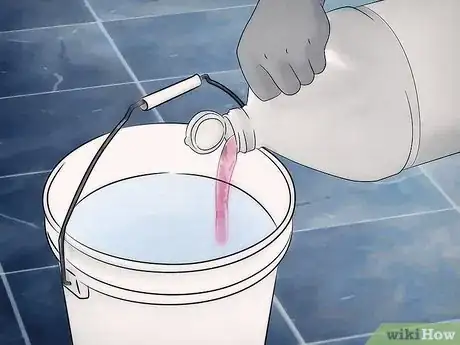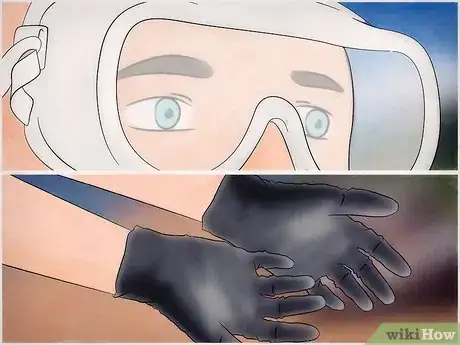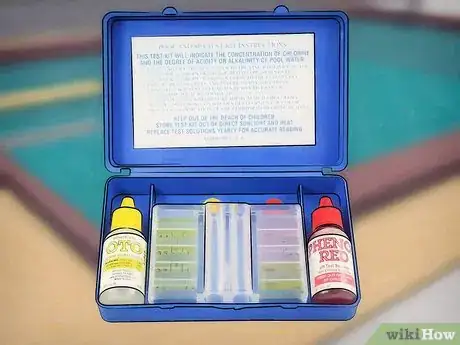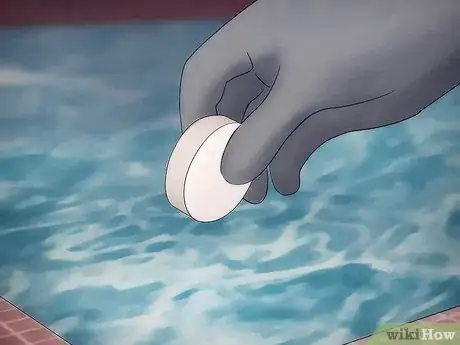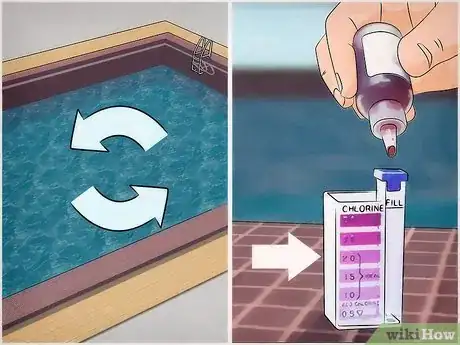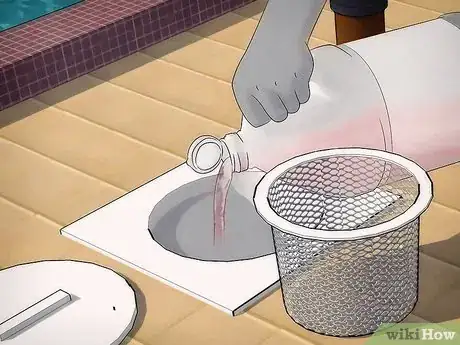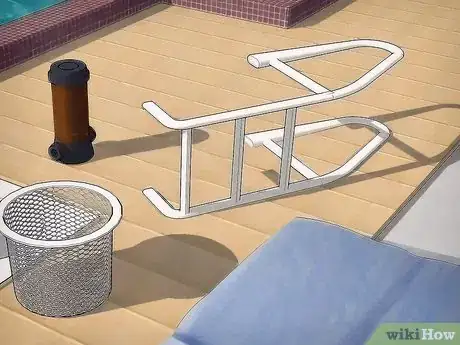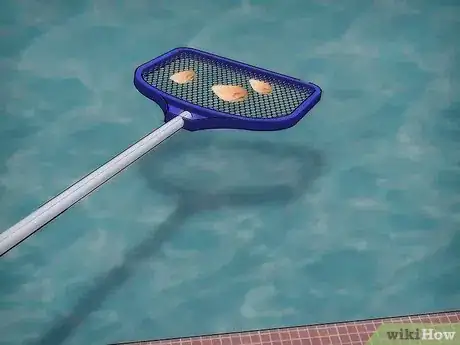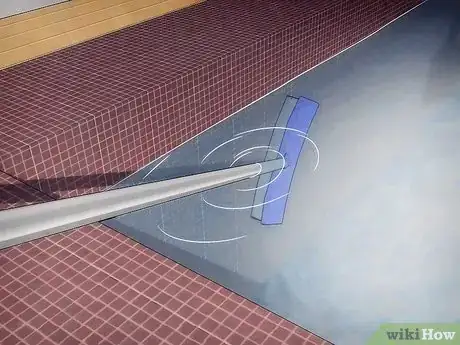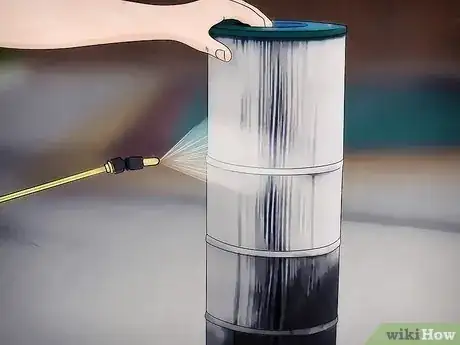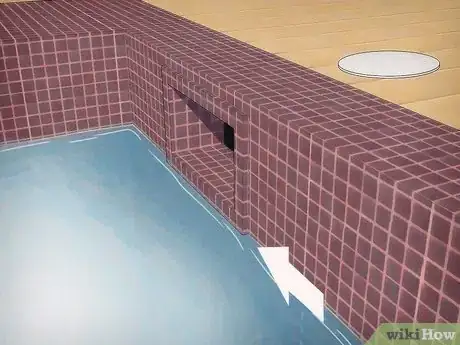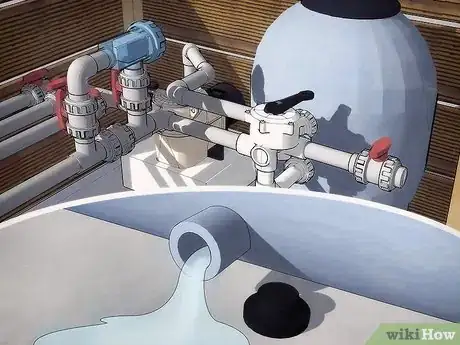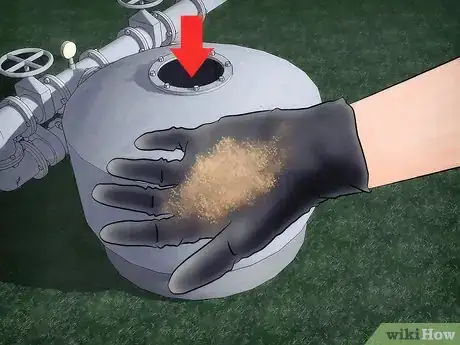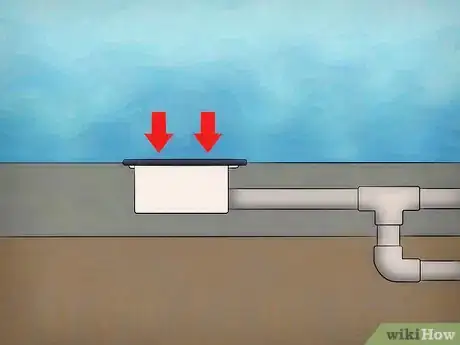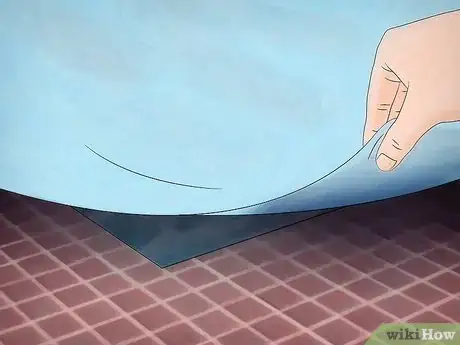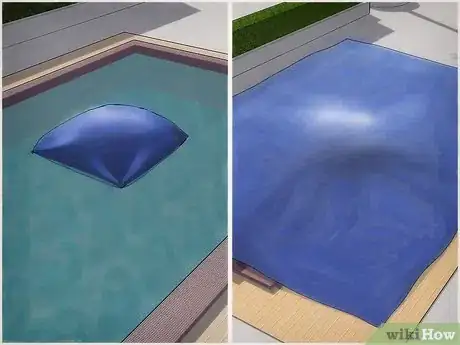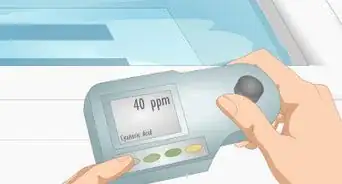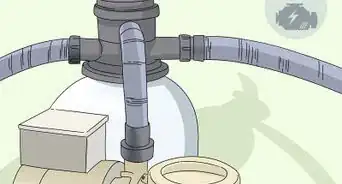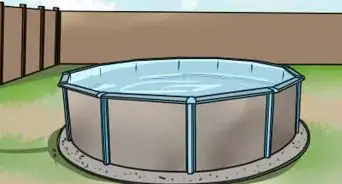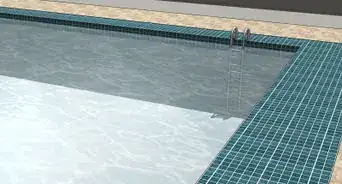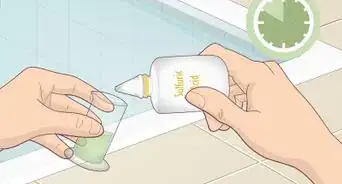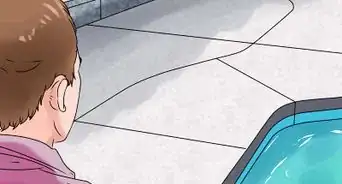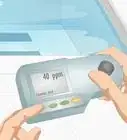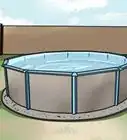This article was co-authored by Rob Litman. Rob Litman is a Landscaper, General Contractor, and the CEO of Vitoli Inc., a landscaping, hardscaping, ecoscaping, and swimming pool design company in Los Angeles, California. With over 20 years of experience in construction, Rob specializes in energy-efficient and drought-tolerant landscaping. He holds General Building Contractor (Class B) and Registered Pool/Spa Contractor Licenses. In 2007, Rob won House of the Year in Gardena, California.
There are 8 references cited in this article, which can be found at the bottom of the page.
wikiHow marks an article as reader-approved once it receives enough positive feedback. In this case, several readers have written to tell us that this article was helpful to them, earning it our reader-approved status.
This article has been viewed 450,959 times.
Properly closing your pool for the winter saves a lot of time and money when you reopen it in the spring. Close the pool a few weeks before the weather turns cold to ensure it's well protected from possible freeze damage (when depends on your weather zone; you might ask knowledgeable neighbors with similar pools and pump/filter systems, or at a pool supply in you area). You might wait to close until the water temperature is well below 60 degrees so, algae is less likely to grow, and if it does, it grows slowly. This article outlines the steps you need to take to winterize your pool.[1]
Steps
-
1Avoid breathing fumes of chemicals. A respirator/dust mask is recommended. Strong fumes of acids, alkali, chlorine, etc. even when partially diluted, and powders, dust of granules, mist of liquids as well as fumes can burn/injure the lungs, bronchial tubes and nostrils.
-
2Never add water into the chemicals. Instead, add chemicals to the pool or into a bucket of water, rather than adding water to a bucket already containing chemicals -- to avoid popping, splatter and fumes of strong chemicals.[2]Advertisement
-
3Use safety goggles and rubber gloves to protect your eyes and hands, when handling chemicals. Avoid chemicals on the skin. Many pool chemicals are very strong acids, alkali, chlorine, etc. Avoid personal injury or damage to your clothing, towels, shoes and other things.[3]
-
4Follow all product label instructions. This ensures effectiveness and safety of use.[4]
Balance the Pool's Water Chemistry
-
1Adjust the pH, alkalinity and calcium hardness. Making sure these are all in balance protects the pool from corrosion or scale buildup that can occur over the winter while the pool is shut down. These adjustments should be made about five days before you completely close down the pool.
- Adjust the pH to a level between 7.2 and 7.6.
- Adjust the alkalinity to 80 to 120 ppm (parts per million).
- Adjust the calcium hardness to 180 to 220 ppm or higher according to product instructions for protecting a plaster pool to lessen minerals dissolving and leeching out.
-
2Shock the water. Use an extra strong chlorine or a non-chlorine substitute to kill bacteria, some of the fungi and algae that may be living in the pool. Buy a shock product with at least 65 percent sodium hypochlorite or a non-chlorine substitute of equivalent strength. Fill a five-gallon bucket with pool water, add the instructed amount of shock granules for the size of pool, and pour it into the pool away from the pool skimmer water outlets while the filtration system is running.[5]
- If you typically use a shock product/mix that is safe for people to swim in right away, it's probably not strong enough to kill all the bacteria in your pool. Since you're closing the pool down, use the instructed stronger shock treatment.
-
3Stay out of the pool until the chlorine level returns to between 1 and 3 ppm over the course of a few days before proceeding to the next step.
-
4Add a winterizing algaecide. Algaecide kills existing algae and prevents more from blooming. Algae can cause the pool to become discolored, give it a bad smell and clog the filter; so, it's important to treat your pool with algaecide before shutting it down.[6]
- Make sure the chlorine level has returned to 1 to 3 ppm before adding algaecide. Otherwise, the chlorine will render the algaecide ineffective.
- Buy an extra-strength algaecide. Use one meant to be used to overwinter a pool, rather than one you add to your pool on an ongoing basis while it's in use. The stronger algaecide is meant to prevent algae from blooming all winter long.
Clean the Pool
-
1Remove everything from the pool that's not water. That includes ladders, baskets, hoses, filters, pumps, heaters, and any decorative pool fittings.
- Rinse all of the pool equipment and lay it out to thoroughly dry.
- Store the equipment in the garage, shed or another dry place through the winter.
-
2Skim the pool. Use a skimming net on a pole to remove all substances floating on the top of the pool, including leaves, insects, and any other debris that may have fallen in. Empty the built-in pool skimmer traps and also the pump leaf and debris catcher. Be thorough, since this is the last time you'll skim the pool before the winter.[7]
-
3Vacuum and brush the pool. Use your pool-cleaning equipment to clean the bottom and sides of the pool.[8]
- If you have a lot of debris on the bottom of the pool, use a skim bag to collect it before vacuuming and brushing.
- You can get a pool vacuum for less than $200 if you don't have one already.
-
4Clean the pool the same day you are shutting it down, to keep more debris from collecting in the meantime.
- The filter needs to be back-washed repeatedly. This is while the pool is working. Later empty the filter, if it is a diatomaceous earth (DE) filter dry and store the filter elements, or perhaps it is a sand filter. Either will be recharged with water in the Spring (more below in the "lower water and drain equipment").
Lower the Water Level and Drain the Equipment
-
1Lower the water with a pump: the "main drain" of an in ground pool can do this using the pool pump, draining from the bottom using the pump "Waste", main control handle setting. Or, it works to setup a vacuum hose as if vacuuming using the skimmer suction so that the pump draws water from below the skimmer level. The water should be lowered below the skimmer and below the water returns according to the type of pool cover you're using.
- If you're using a mesh cover, lower the water 12 to 18 inches (30.5 to 45.7 cm) below the skimmer.
- If you're using a solid, floating cover, lower the water to 3 to 6 inches (7.6 to 15.2 cm) below the skimmer.
-
2Drain the equipment. All pumps, filters, heaters and chlorinators need to be drained of water before the winter. Remove the skimmer basket(s) and return eyeball(s). (If water were to freeze inside the equipment, it could damage or ruin it.)
- Open the drains on each piece of equipment to release the water inside.
-
3Empty and open the filter case to clean it and the filter very thoroughly. Store the filter elements in a dry place inside for the winter. If it is a DE filter the filter elements can be removed and replaced one by one. The excess DE settled in the bottom may need to be removed by hand -- or there may be a drain plug on the filter, near the bottom.
- Or, if it is a sand filter, the sand may need to be cleaned manually and may need to be replaced if it is not cleanable.
- If the filters cannot be removed, blow carefully with a shop vacuum to help remove the remaining water out of them. An air compressor might build up excessive pressure in the system or damage the system otherwise.
-
4Winterize the plumbing. The lines running/returning water into your pool need to be dried out so they don't freeze and crack over the winter.
- Use a shop vacuum to blow air into the skimmer outlet pipe, through the equipment and back into the pool. If you have more than one skimmer this should be done one by one. Use expansion plugs to plug the lines at the returns and in the skimmer; so water doesn't enter them.
- Or, if you don't blow out the lines, you can add swimming pool antifreeze (not automotive) to them to prevent remaining water from freezing. Put 1/2 gallon of antifreeze above the plug in the skimmer(s). Put a styrofoam chunk or a plastic bottle in the skimmer as a doughnut to prevent damage to the skimmer from any possible freezing, if rain water or snow-melt drains into it. Follow the manufacturer's instructions.
Finish Closing the Pool for the Winter
-
1Cover the pool. The floating tarp cover is not child/pet proof.[9] It's essential to use a cover that fits well and doesn't leave any gaps or cracks for debris to enter the pool over the winter.
- An anchored, strapped down, reinforced, mesh safety cover would tightly fit the pool to protect it. It helps prevent a child or pet from wandering into the pool.
- Waterproof, "solid floating covers" (like large, flexible-vinyl tarps) lie loosely on the surface of the lowered pool water and run up the walls. Some people add a little water on top of the cover to keep the surface weighted down. Watch to see whether you need to clean debris off the cover. It may be necessary to pump rainwater, snow-melt off the cover. You could use an automatic cover pump on the cover for as long as water getting on the tarp fall through spring.
- Scatter 1/2 full water bags around the edges of the pool, out of your way. Center the cover over the pool. Press the cover edges down so it lies on the water, and the remainder lies on the deck.
- Fold any excess cover under and weight all edges with the water bags so there is no part of the tarp to blow around the entire edge of the pool. Water bags can be emptied for storage in the spring, while sand bags are not convenient.
- If you have trees that would continue to shed leaves surrounding your pool, you can place a leaf net over it to catch debris to prevent a soggy mess on top off the cover. Some trees shed all leaves in 3 weeks are not a continual problem.
-
2Use air pillows. Air pillows prevent the expansion of ice in above-ground pools, but they aren't necessary to use in in-ground pools.
- Inflate air pillows with a leaf blower or shop vacuum and tie them down in the center of the pool.
- Larger pools require two or more air pillows.
Community Q&A
-
QuestionShould the skimmer valves be open or closed for the winter?
 Community AnswerSkimmer valves should remain closed so winter air can not get in and ruin your pool.
Community AnswerSkimmer valves should remain closed so winter air can not get in and ruin your pool. -
QuestionDoes the pool have to be balanced before I close it and put on the cover?
 Community AnswerNo. You may want to shock it to deter the growth of algae, however.
Community AnswerNo. You may want to shock it to deter the growth of algae, however. -
QuestionHow much water should I leave in the pool?
 Community AnswerSlightly less than the water you would usually have in your pool in the summer.
Community AnswerSlightly less than the water you would usually have in your pool in the summer.
Warnings
- Keep a pool alarm active during the winter months. Pets and children will have accidents regardless of the season. It is always too cold to swim in the Winter.[10]⧼thumbs_response⧽
- Never completely drain a pool - Hydrostatic pressure can cause damage.⧼thumbs_response⧽
- Do not use automobile antifreeze in pool lines.⧼thumbs_response⧽
Things You'll Need
- Pool test kit
- Winterizing chemicals (kit)
- Algaecide
- Shock treatment chemical
- Filter cleaner chemical
- Pool cover (leaf net optional)
- Pool cleaning equipment
References
- ↑ https://www.swimuniversity.com/close-inground-pool/
- ↑ https://www.cdc.gov/healthywater/swimming/aquatics-professionals/preventing-pool-chemical-events.html
- ↑ https://chlorine.americanchemistry.com/Pool-Chemical-Safety-Resources/
- ↑ https://www.cdc.gov/healthywater/swimming/aquatics-professionals/preventing-pool-chemical-events.html
- ↑ https://www.swimuniversity.com/pool-shock/
- ↑ https://www.poolcenter.com/winterClosings
- ↑ https://www.swimuniversity.com/close-inground-pool/
- ↑ https://www.swimuniversity.com/close-inground-pool/
- ↑ https://www.healthychildren.org/English/safety-prevention/at-play/Pages/Pool-Dangers-Drowning-Prevention-When-Not-Swimming-Time.aspx

